H4 - Replication, Partitioning and Transactions
1/37
There's no tags or description
Looks like no tags are added yet.
Name | Mastery | Learn | Test | Matching | Spaced |
|---|
No study sessions yet.
38 Terms
Reasons for distributing data
Scalability: spread data volume, read load or write load across multiple machines
Fault tolerance / high availability: if your application needs to continue working even if one machine (or several, or the network, or a data center) goes down, you can use multiple machines to give you redundancy
Latency: if you have users around the world, you may want to have servers at variouslocations worldwide so that each user can be served from a datacentre geographically close to them
Cluster architecture (figuur)
denk aan datacenter
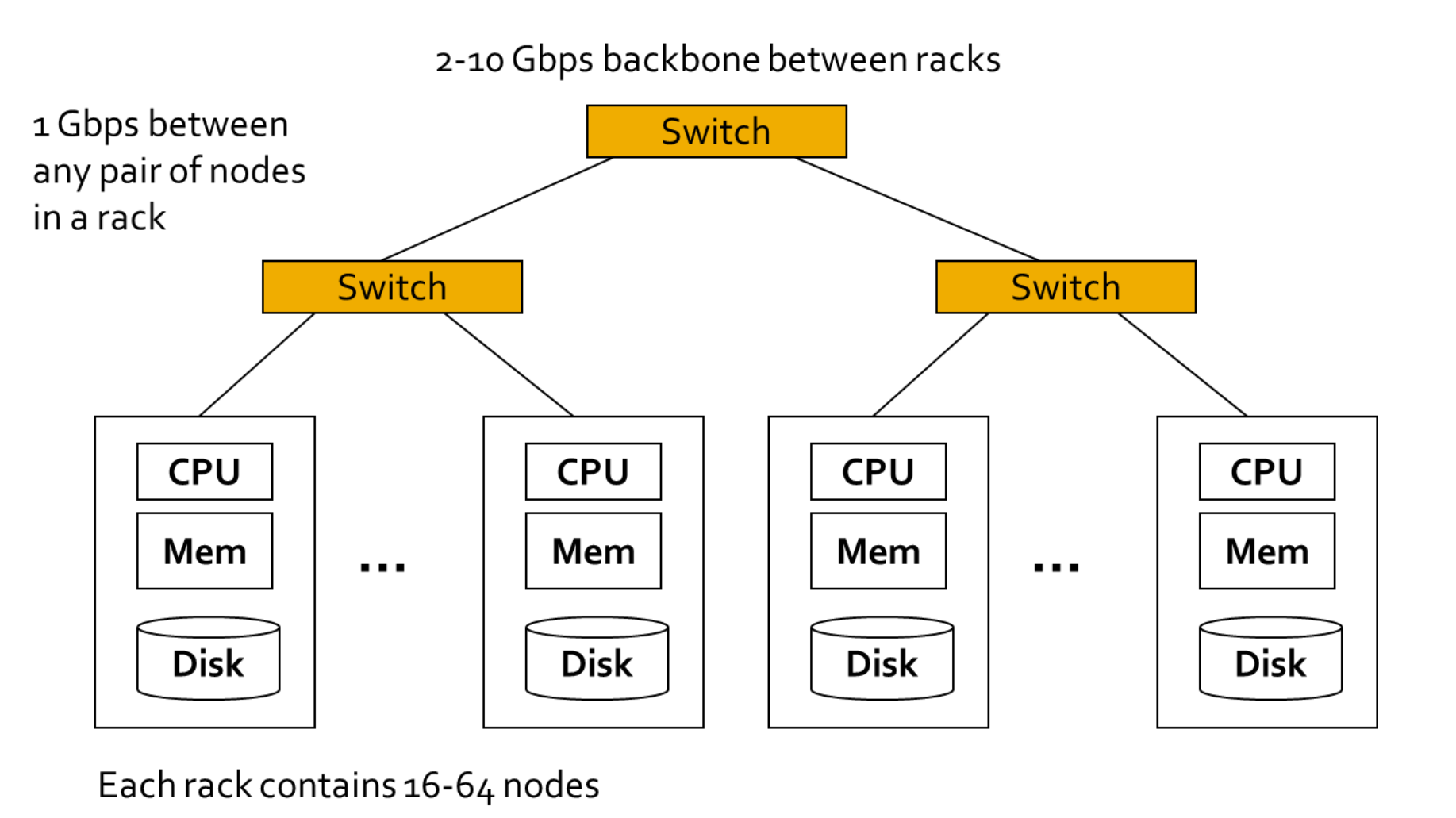
vertical scaling
Vertical scaling = buy a more powerful machine
Shared memory architecture: multiple CPUs all accessing any part of the memory or disk
Issues: cost, non-linear performance increases, performance ceiling, limited fault tolerance, single geographic location
Shared-disk architecture: several machines with independent CPUs, data is stored on a shared array of disks interconnected via fast network (e.g. Fiberchannel)
Issues: contention, overhead of locking
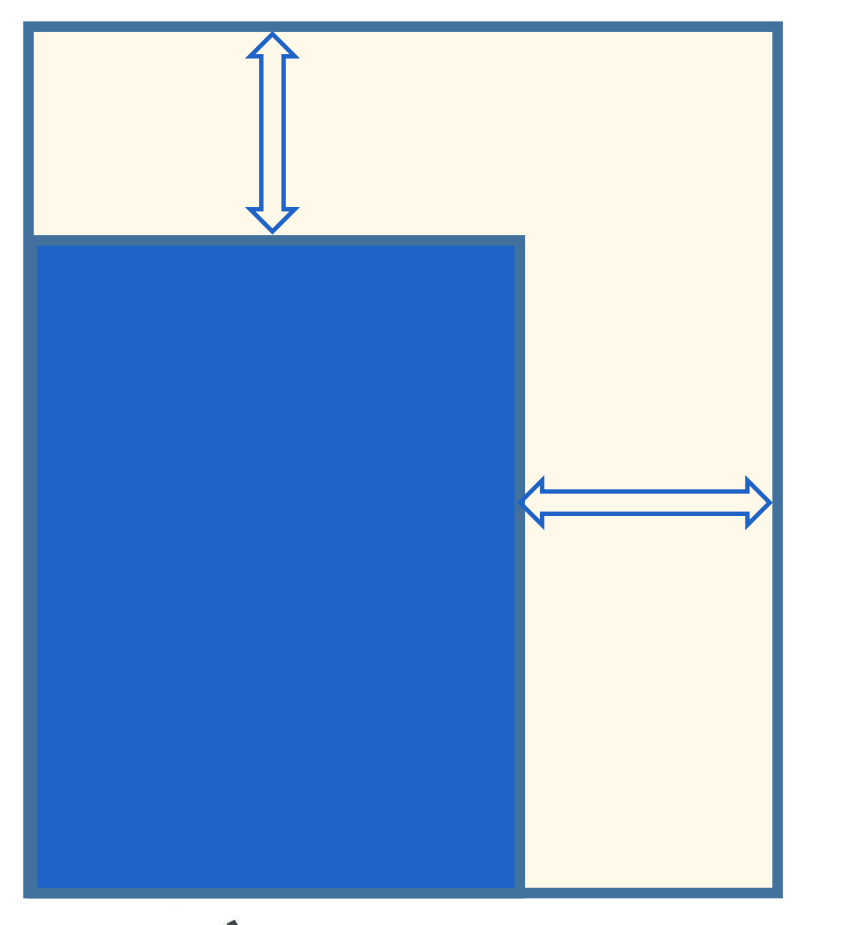
Horizontal scaling
Horizontal scaling (a.k.a. shared-nothing architectures): throw more resources at it
Each node has its CPUs, RAM and disks independently
Coordination between nodes is done at the software level, using a conventional network
No special hardware required
Currently mostly VMs / containers
Nodes can be distributed over geographic regions, reducing latency and potentially allowing to survive the loss of a data center
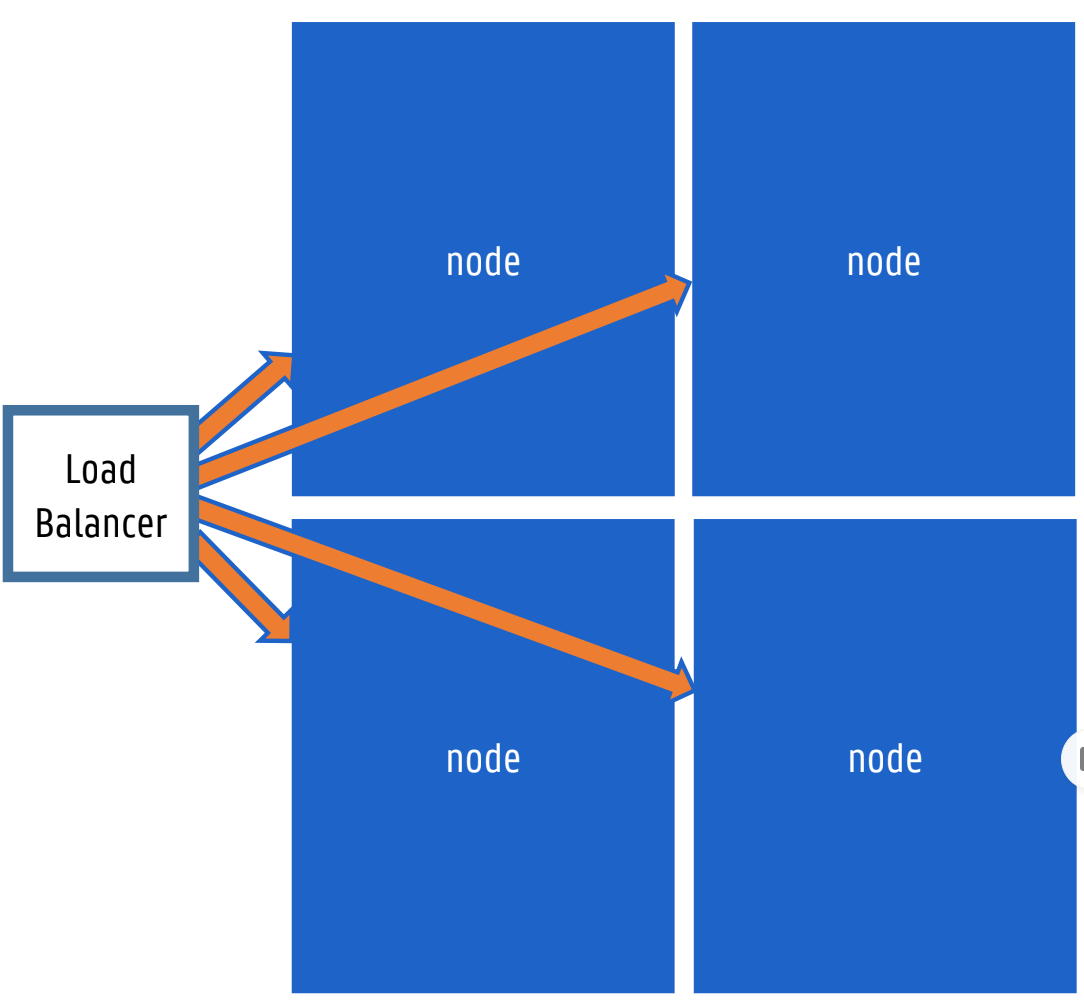
Cloud computing (wat)
Computing as a utility
Utility services: water, electricity, gas
Consumers pay based on their usage
Why now?
Experience with very large datacenters
Technology factors
Business factors
Replication vs Partitioning
→ simpel vb/figuur kunnen geven
Two common ways of distributing data across multiple nodes
Replication
Keeping a copy of the same data on several different nodes, potentially in different locations
Provides redundancy
Can help improve performance
Partitioning
Splitting a DB into smaller subsets called partitions so that different partitions can be assigned to different nodes
Helps improve performance
Partitioning an sich is geen oplossing voor redundantie! (fouttolerantie verhoogt)
-> altijd gebruiken in combinatie met replication
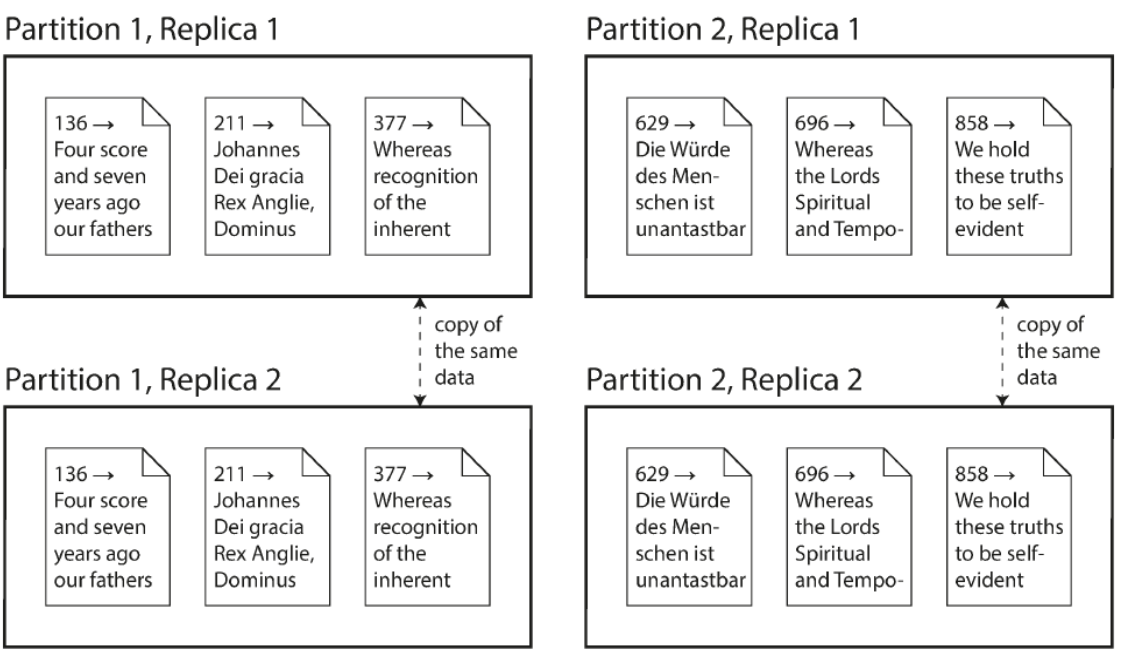
Replication: reasons
Reasons to replicate data
Reduce latency: keep data geographically close to your users
Increase availability: allow the system to continue working even if parts have failed
Increase throughput: scale out the number of machines that can serve read queries
Here: assume dataset can be replicated fully to each machine
If data that needs replicating does not change over time replication is easy, just copy the data to every node
Difficulty: handling replication with changing data
Replication: leaders and followers
basisprincipe
figuur!
Each node that stores a copy of the DB is called a replica
Multiple replicas: how do we ensure that all data ends up on all replicas?
Every write to the DB needs to be processed by every replica
Solution: leader-based replication (a.k.a. master-slave replication)
One of the replicas is designated as leader (a.k.a. master or primary)
Clients want to write to DB → send request to leader → leader writes new data to local storage
Other replicas are followers (replicas, slaves, secondaries).
When leader writes new data to local storage → sends data change to all followers as part of a replication log or change stream
Each follower takes log from leader and updates local copy of the DB, applying all writes in the order as they were processed on the leader
When a client wants to read from the DB, it can query either the leader or any of the followers
Writes only accepted on the leader (followers are read-only for clients)

Replication: leaders and followers
sync vs async replication
figuur!
Synchronous replication: leader waits until follower has confirmed it received the write
Before reporting success to the user
Before making the write visible to other clients
Follower is guaranteed to have an up-to-date copy of the data consistent with the leader
If the follower doesn’t respond, the write cannot be processed
Asynchronous replication: leaders sends the message, but does not wait for response from follower
If leader fails and is unrecoverable, any writes that have not yet been replicated to followers are lost (gevaarlijk)
Can continue processing writes, even if all of its followers have fallen behind
In practice typically a mix: one follower will be synchronous, the others asynchronous
If the synchronous follower becomes unavailable or slow: promote an async follower to sync
A.k.a. semi-synchronous → meeste gevallen

Replication: leaders and followers
Setting up a new follower
Take a consistent snapshot of leader’s DB at some point in time
Same feature as required for backups
If possible without taking a lock on the DB
Copy snapshot to new follower node
Follower connects to leader and requests all data changes that happened since snapshot was taken
Snapshot must be associated with an exact position in the leader’s replication log
When follower has processed backlog of data changes since snapshot, it has caught up
Can now continue to process data changes from leader as they happen
Replication: leaders and followers
handling node outages: follower
Any node in the system can go down
Unexpected due to fault
Planned maintenance (e.g. rebooting for kernel patch)
Goal
Keep system as a whole running despite individual node failures
Keep impact of node outage as small as possible
Follower failure: catch-up recovery
On local disk, each follower keeps log of data changes it received from leader
If a follower goes out
From its log it knows the last transaction that was processed before the fault occurred
Can request all data changes since that time from the leader
When those changes are applied, it has caught up and can continue receiving a stream of data changes as before
Replication: leaders and followers
handling node outages: Leader
Leader failure: failover
One of the followers promoted to new leader
Clients reconfigured to send their writes to new leader
Other followers start consuming data changes from new leader
Failover can be done manually or automatically
Determining that the leader has failed
Most systems use a timeout – if a system does not respond for an amount of time it is assumed dead
Choosing a new leader
Can be done through election process or new leader can be appointed by a controller node
Best candidate for leadership is usually the replica with the most up-to-date data changes
Getting all nodes to agree on new leader = consensus problem
Lots of different consensus protocols a.o. Paxos, Bitcoin’s proof-of-work, etc.
Reconfiguring system to use new leader
Clients send write requests to new leader
When old leader comes back, it may not realize it was forced to step down
System needs to ensure old leader becomes follower and recognizes new leader
Replication: leaders and followers
handling node outages: when failover goes wrong
If async replication is used, new leader may not have received all writes from old leader before failure
When former leader rejoins, what should happen with those writes?
New leader may have received conflicting writes in the meantime
Usually: discard unreplicated writes
Discarding writes is dangerous if other storage systems coordinate with DB content
Example: GitHub incident saw an out-of-date MySQL follower promoted to leader
DB used autoincrement counter to assign primary keys to new rows
New leader reused some primary keys that were assigned by the old leader - Those keys were used in a Redis store, so reuse resulted in inconsistency between MySQL and Redis, leading to disclosure of private data to wrong users
In certain scenarios it can happen that two nodes both believe they are leader (a.k.a. split brain)
Dangerous if both leaders accept writes and there is no process for resolving conflicts
Data likely lost or corrupted
Safety catch: some systems have a mechanism to shut down one node if two leaders are detected
Can trigger dual leader shutdown if not carefully designed
What is the right timeout before the leader is declared dead?
Longer timeout = longer time to recovery in case where leader fails
Short timeout = potential for unnecessary failovers
Replication: leaders and followers (EX)
problems with replication lag: algemeen
3 main problems
Leader-based replication
Requires all writes to go through single node
Read-only queries can go to any replica
For workloads that consist of mostly reads and only small percentage of writes (common on the web) an attractive option is to create many followers and distribute reads across those followers
Removes load from leader and allows read requests to be served by nearby replicas
A.k.a. read-scaling architecture
Only realistically works with asynchronous replication
Synchronous: single replica node failure holds up whole system for writing
When application reads from asynchronous follower it may see outdated information if follower has fallen behind
Same query on leader versus on fallen behind follower = inconsistent
Temporary: stop writing to DB and followers will eventually catch up and become consistent: dubbed eventual consistency
Replication lag = delay between write happening on leader and reflected on follower
With large lag, issues for applications start to arise
Three main issues discussed next
Reading your own writes
monotonic reads
consistent prefix reads
Replication: leaders and followers (EX)
problems with replication lag: Reading your own writes
figuur!
When new data is submitted, it must be sent to leader
When user views data, it can be read from a follower
Asynchronous replication
If user views data shortly after making a write, new data may not yet have reached replica
Looks like data submitted was lost

Requires read-after-write consistency (a.k.a. read-your-writes consistency)
If user reloads page, they always see any updates they submitted themselves
Makes no promises about other users: other users’ updates may not be visible until some later time
Implementation
When reading what user may have modified: read it from leader, otherwise read it from follower
E.g. social network profile is only editable by owner of profile → read user’s own profile from leader, any other profile from follower
If most things are potentially editable by user track time of last update and, for a configurable time (e.g. based on replication lag) after last update, make all reads from leader
Client can remember timestamp of most recent write → system makes sure that replica serving reads for that user reflects updates until that timestamp
Timestamp can be log sequence number or actual system clock (requires clock synchronisation)
Note: more complications when multi-device access is considered (e.g. desktop + mobile app)
Replication: leaders and followers (EX)
problems with replication lag: Monotonic reads
figuur!
Reading from async followers can make users see things moving backward in time
If user makes several reads from different replicas
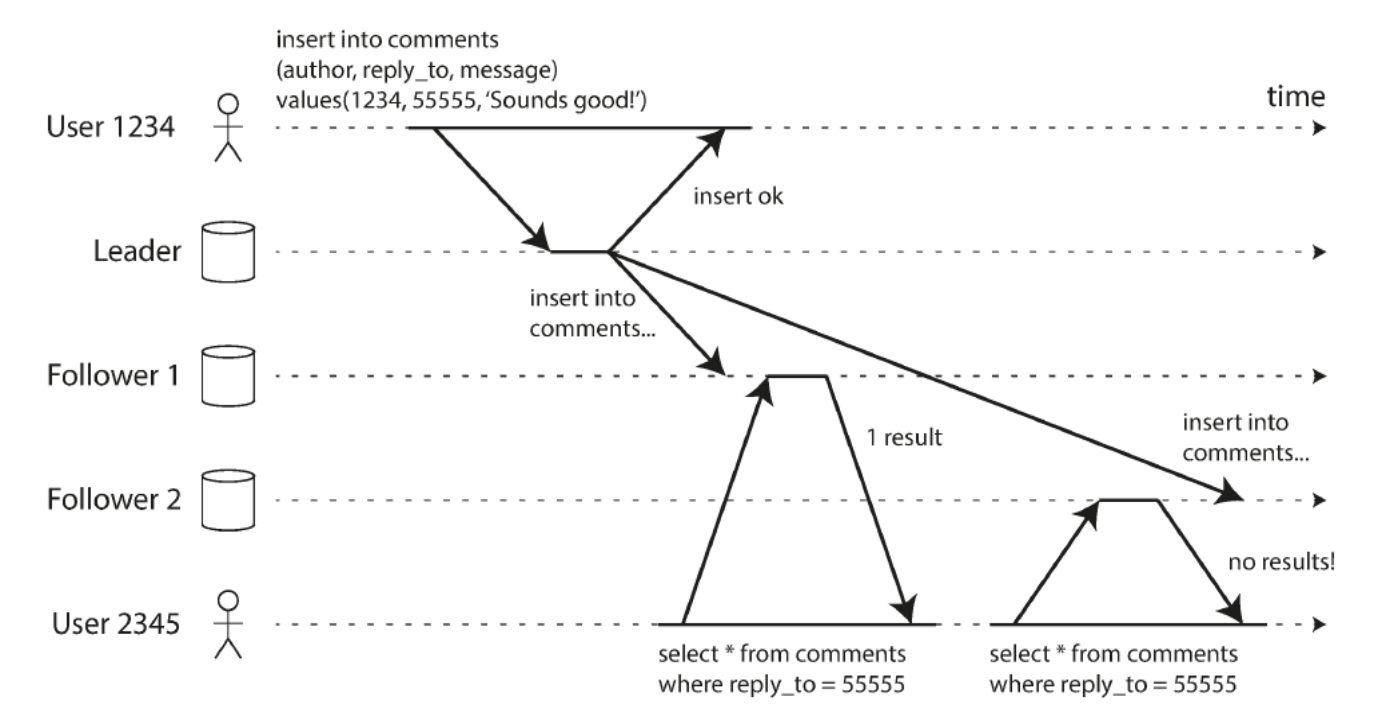
Monotonic reads is a guarantee that this kind of anomaly does not happen
Lesser guarantee than strong consistency, but stronger than eventual consistency
Guarantees that if user makes several reads in sequence, they will not read older data after having previously read newer data e.g. by making sure user always makes reads from same replica
Replica can be chosen based on hash of user ID, but if that replica fails the user’s queries will need to be rerouted to another replica
Replication: leaders and followers (EX)
problems with replication lag: Consistent Prefix Reads
figuur!
Imagine following dialog
Mr. Poons: how far into the future can you see Mrs. Cake?
Mrs. Cake: about ten seconds usually, Mr. Poons
Imagine third person listening to conversation through followers
Second sentence goes through follower with little lag, first sentence has longer replication lag
Observer would see as though answer comes before question
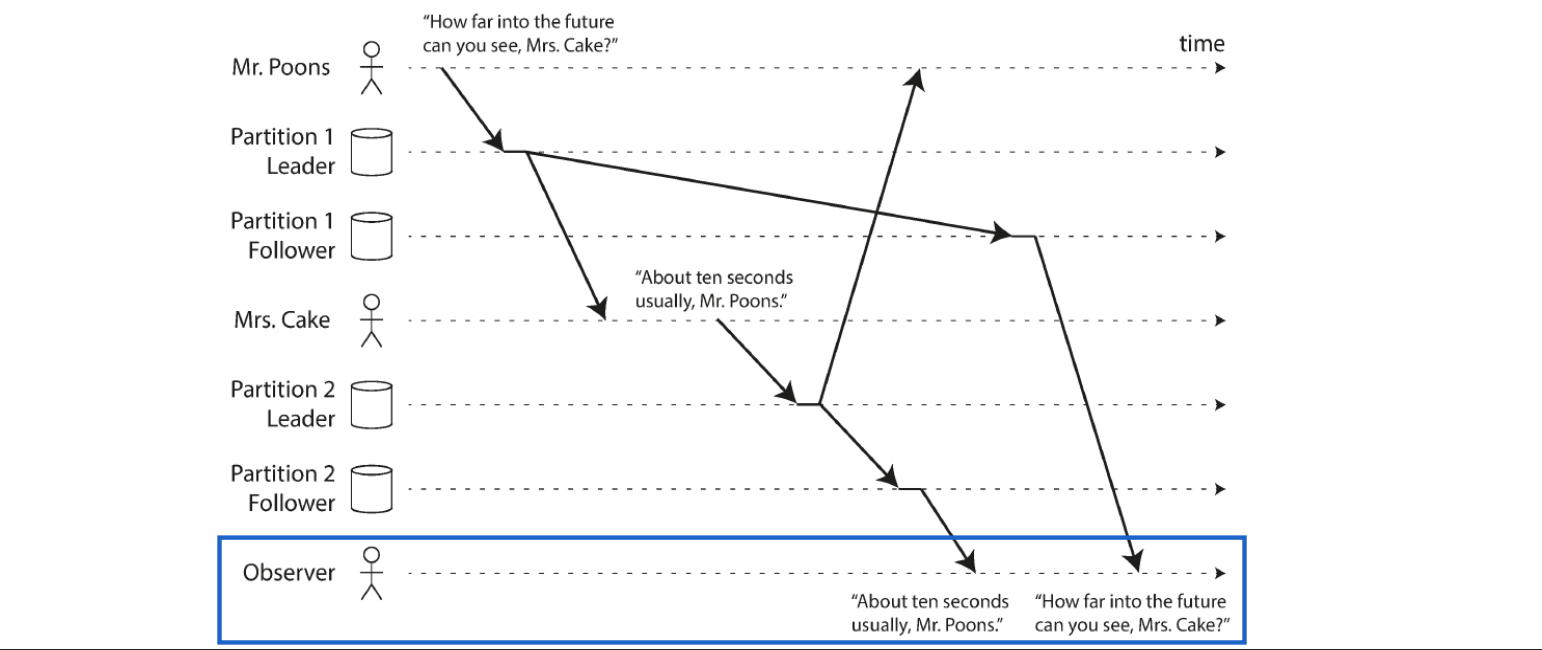
Preventing this anomaly requires consistent prefix reads
Guarantees that if a sequence of writes happens in a certain order, then anyone reading those writes will see them appear in the same order, maakt het wel complexer door oa. meer verwerking v. metadata
Replication: Multi-leader replication (EX)
algemeen
figuur!
Only one leader → all writes must go through leader
Multi-leader replication (a.k.a. master-master replication)
Allow more than one node to accept writes
Each node that processes a write must forward that data change to all other nodes
Mostly used in multi-datacentre configurations
Can have a leader in each datacentre
Within each datacentre, regular leader-follower replication is used
Between datacentres, each datacentre’s leader replicates its changes to leaders in other datacentres

Replication: Multi-leader replication
comparing single and multi leader
in multi datacentre deployments
disadvantages multi leader
modern multi-leader applications
In multi-datacentre deployments
Performance
Single leader: every write must go over the internet to leader’s datacentre (can add significant latency)
Multi-leader: every write can be processed in local datacentre and is replicated asynchronously to other datacentres
Tolerance of datacentre outages
Single leader: if datacentre with leader fails, failover can promote a follower in another datacentre to be leader
Multi-leader: each datacentre can continue to operate independently, replication catches up when failed datacentre comes back online
Tolerance of network problems: traffic between datacentres usually goes over public internet, less reliable than local network within a datacentre
Single leader: very sensitive to problems in the inter-datacentre link, because writes are made synchronously over this link
Multi-leader: can tolerate network problems better, temporary network interruption does not prevent writes being processed
Disadvantage multi-leader
Same data may be concurrently modified in two different datacentres - those write conflicts must be resolved
Multi-leader replication often considered dangerous territory - difficult to get right
Modern multi-leader applications
Clients with offline operation e.g. calendar apps on mobile phone/laptop
If you make any changes while you are offline, they need to be synced with a server and your other devices when the device is online
Every device has local DB that acts as leader (accepts write requests) and there is an asynchronous multi-leader replication process (sync) between the replicas of your calendar on all your devices
Collaborative editing e.g. Google Docs: when one user edits a document, the changes are instantly applied to their local replica and asynchronously replicated to server and any other users who are editing the same document
Replication: Multi-leader replication
Multi leader write conflicts
figuur!
Multi-leader replication can produce write conflicts
Upon write conflict: conflict resolution required
Conflict resolution algorithms out-of-scope
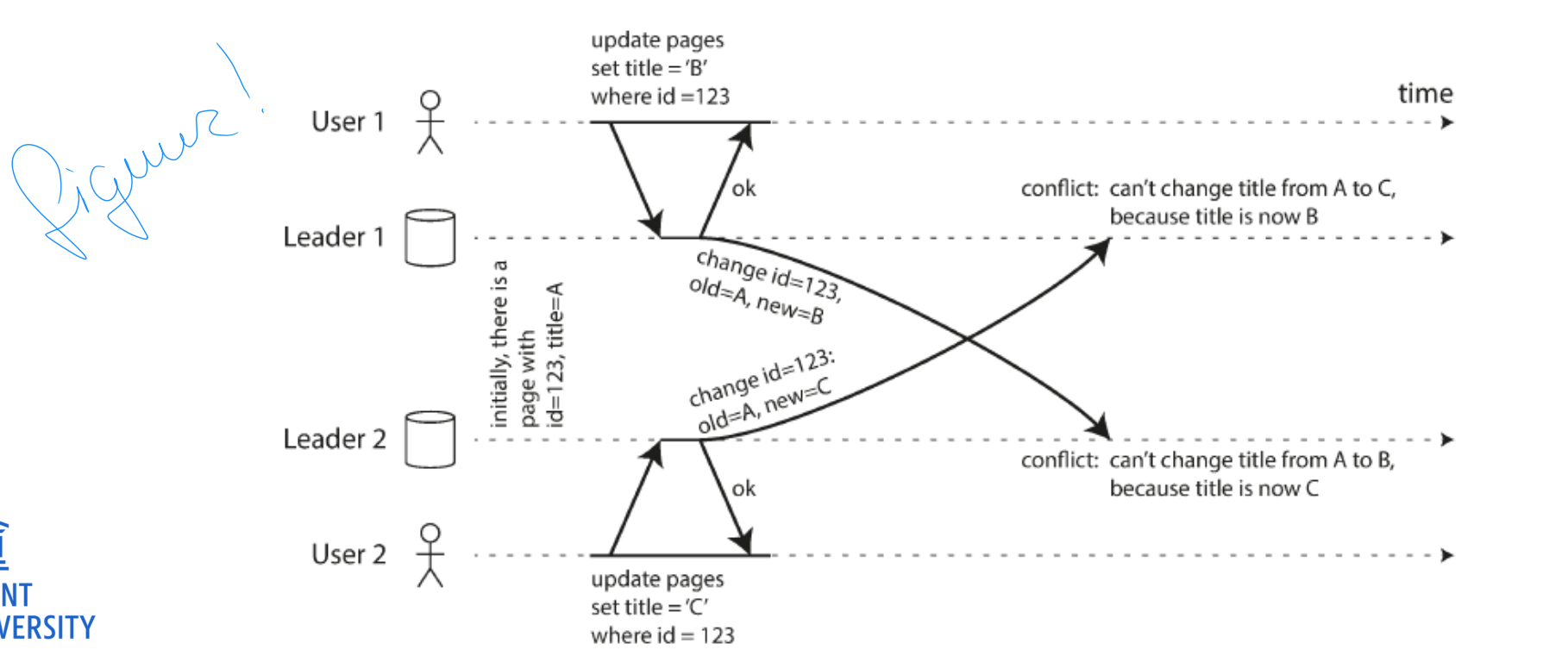
Replication: Multi-leader replication
Replication topologies (3)
figuur!
Replication topology: describes communication paths along which writes are propagated from one node to another
Circular topology: each node receives writes from one node and forwards those writes (+ any writes of its own) to one other node (gevaarlijk)
Star topology: one root node forwards writes to all other nodes
All-to-all: every leader sends its writes to every other leader

Replication: Leaderless replication
algemeen
What if we abandon the concept of a leader and allow any replica to directly accept writes from clients?
Became fashionable again after Amazon used it for in-house Dynamo system
Cassandra is an open source datastore with leaderless replication models inspired by Dynamo
Sometimes called Dynamo-style
Sometimes client sends writes directly to several replicas, while in others a coordinator node does this on behalf of the client
Coordinator does not enforce a particular ordering of writes
Replication: Leaderless replication
Writing when a node is down
figuur!
DB with 3 replicas, one of the replicas is currently unavailable
Client sends write to all 3 replicas in parallel
2 available replicas accept the write, unavailable one misses it
2 of 3 replicas acknowledge the write, and user considers write to be successful, ignoring fact that 1 write was missed
Unavailable node comes back online and clients start reading from it
Potential for stale / outdated values from that node

Solution: when client reads from DB, request data from several nodes in parallel
Client may receive different responses, version numbers used to determine which value is newer
Replication: Leaderless replication
Read repair and anti entropy
Replication scheme should ensure that eventually all data is copied to every replica
After an unavailable node comes back online it must catch up on missed writes. Two mechanisms often used
Read repair: when a client makes a read from several nodes in parallel, it can detect stale information. Client sees that replica 3 has stale value and writes newer value to that replica
Anti-entropy process: background process that constantly looks for differences between replicas and copies any missing data from one replica to another
Partitioning algemeen
(eventueel figuur ter illustratie)
Partitioning: for very large datasets or very high query throughput
Need to break data up into partitions a.k.a. sharding
Normally each piece of data belongs to exactly one partition
Main reason: scalability
Partitioning usually combined with replication so copies of each partition are stored on multiple nodes

Partitioning: partitioning of key-value data
algemeen
Goal: spread data and query load evenly across nodes
Skewed = presence of uneven spread
Partition with disproportionally high load is called a hot spot
Easiest solution would be to distribute data randomly to nodes
But when reading, no way of knowing which node data is on, so would have to query all nodes in parallel
Partitioning: partitioning of key-value data
partition by key range
partition by hash of key
compromise
Assign continuous range of keys (from some minimum to some maximum) to each partition
Due to known boundaries between ranges, able to determine which partition contains given key → can make request directly to appropriate node
Range of keys not necessarily evenly spaced, because data may not be evenly distributed
Within partitions keys can be kept in sorted order
E.g. when key is timestamp, queries can easily fetch all reading from particular month
Downside: when writing data to DB, all current writes end up going to same partition (serving current time/day) so partition can be overloaded while others sit idle
Can be resolved by partitioning by means of prefix (e.g. sensor generating value) and then by time
Downside: when wanting to fetch values of multiple sensors within a time range, need to perform a separate query for each sensor name

Many distributed datastores use a hash function to determine partition for a given key
A good hash function takes skewed data and makes it uniformly distributed e.g. MD5
32 bit hash function of string returns a seemingly random number between 0 and 232 – 1
Downside: lose the ability to do efficient range queries
Adjacent keys now scattered across all partitions (figure below)

Compromise can be achieved by declaring compound primary keys consisting of multiple columns
Only first column of key is hashed to determine partition, others used as an index for sorting data
If a query specifies a fixed value for the first column, it can perform an efficient range scan over the other columns of the key (e.g. user_id, update_timestamp) → retrieve all updates made by a particular user within some time interval, sorted by timestamp
Partitioning: partitioning of key-value data
skewed workloads and hot spots (bij hashing)
Hashing a key to determine a partition can help reduce hot spots, but cannot avoid them entirely
If most reads / writes are for same key → all requests routed to same partition
E.g. social media site celebrity does something
Solution
If key is considered to be very hot, add random number to beginning or end of key, splitting writes to key evenly
Those keys can now be distributed across different partitions
Reads now have to do additional work: read data from all partitions and combine them
Add overhead to that (tracking which keys are split and which aren’t)
Partitioning: partitioning and secondary indexes
algemeen
What if records are not only accessed by their primary key?
Secondary indexes: does not identify a record uniquely but rather a way of searching for occurrences of a particular value
Examples
Find all articles containing the word hogwash
Find all cars whose color is red
Problem: secondary indexes do not map neatly to partitions
Two approaches
Document-based partitioning
Term-based partitioning
Partitioning: partitioning and secondary indexes (EX)
Document based partitioning
figuur
Each partition maintains own secondary indexes, covering only documents in that partition
Whenever writing to DB → only need to deal with partition that contains document ID that you are writing
Also known as local index (instead of global index)
Reading requires care: need to send query to all partitions and recombine results (a.k.a. scatter/gather)
Widely used, but can make reads expensive
Example: operate a website for selling used cars
Each listing unique ID (doc ID) and DB partitioned by doc ID
Users can search for cars filtering by color and make (both secondary indexes)
DB can be configured to put indexes on color and make
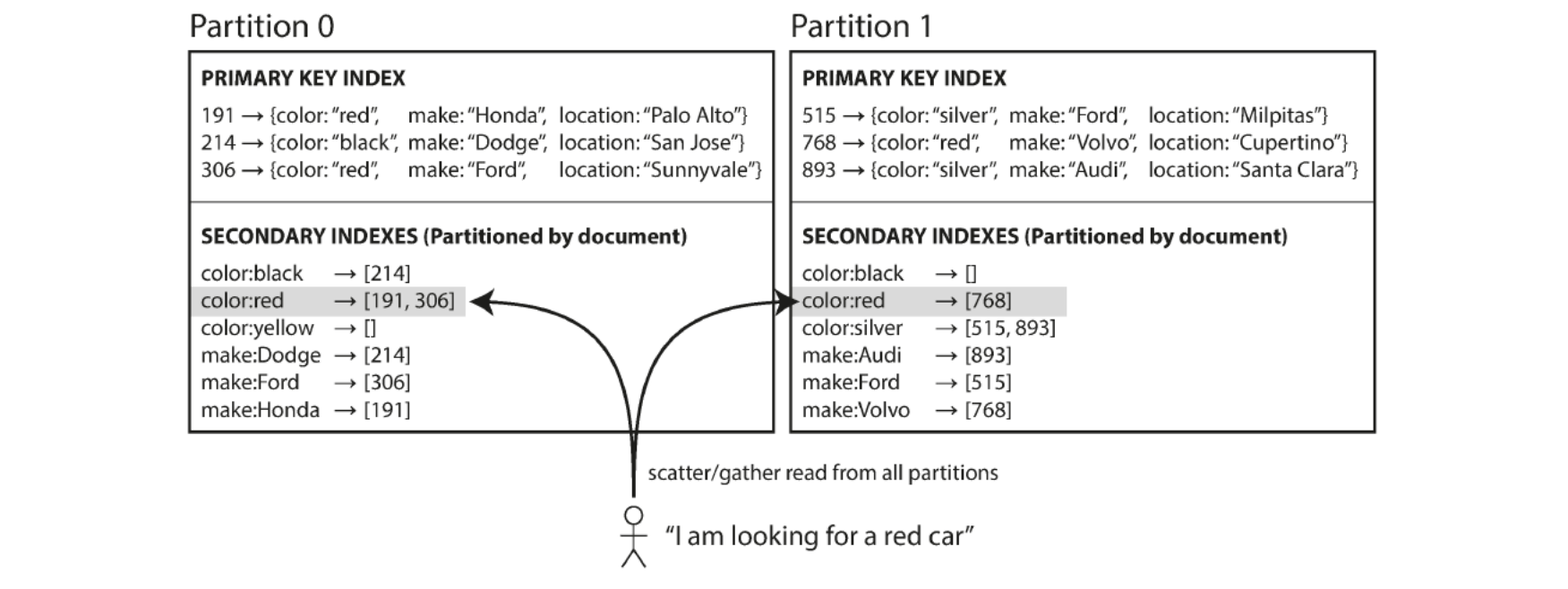
Partitioning: partitioning and secondary indexes (EX)
Term based partitioning
figuur
Rather than each partition having own secondary index construct a global index covering data in all partitions
Unable to store that index on one node as it would become a bottleneck
Index itself must be partitioned but can be partitioned differently from primary key index
Makes reads more efficient= no more scatter/gather over all partitions
Writes are slower and more complex
Write to a single document may affect all partitions of the index
Index not always up to date, otherwise would need distributed transactions
Index updates often asynchronous
Partitioning: Rebalancing strategies
algemeen
Over time things change
Query throughput increases: more CPUs needed
Dataset size increases: more disks and RAM needed
Machine fails, other machines need to take over failed machine’s responsibilities
All these changes call for data and requests to be moved from one node to another → this process is called rebalancing
Rebalancing goals
After rebalancing load should be shared fairly between nodes in cluster
While rebalancing is happening, DB should continue accepting reads and writes
No more data than needed should be moved between nodes, to make rebalancing fast and to minimize network and disk I/O load
Do not do hash mod N
Problem: if N changes most keys will need to be moved from one node to another → Excessively expensive
Partitioning: Rebalancing strategies
fixed number of partitions (figuur)
dynamic partitioning (proportionally to the dataset)
partitioning proportionally to nodes
Fixed number of partitions
Create many more partitions than there are nodes and assign several partitions to each node e.g. cluster of 10 nodes may be split into 1000 partitions from the start so each node hosts +/- 100 partitions
If node is added to cluster, new node steals partitions from every existing node until partitions are fairly distributed again
Reverse process if node is removed from cluster
Number of partitions and assignment of key to partition does not change
Old assignment of partitions is used for any reads/writes that happen while rebalancing transfer is in progress
Can account for heterogenous hardware in cluster: more powerful nodes get more partitions
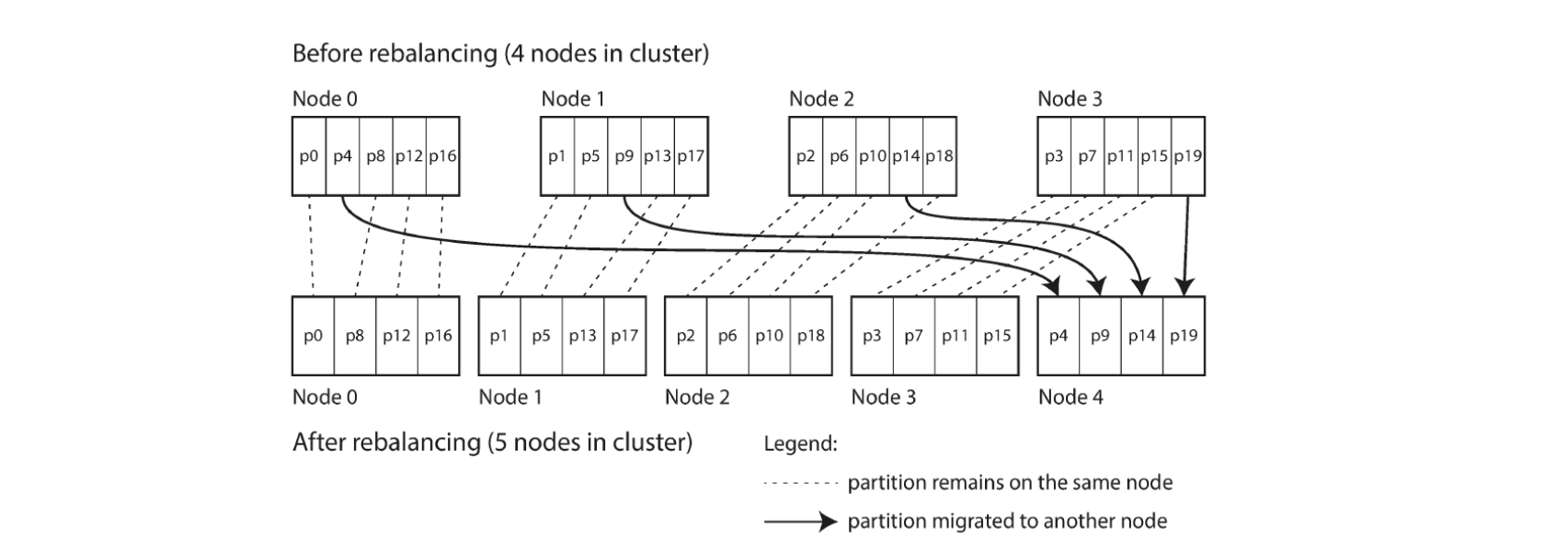
Dynamic partitioning (proportionally to the dataset)
When partition grows over a configurable size, it is split into two partitions so +/- half the data ends up on each side of the split
If a partition shrinks below some threshold, it can be merged with an adjacent partition
Benefit: number of partitions adapts to total data volume
Drawback: empty DB starts with one partition, so all writes have to be handled by a single node while other nodes sit idle
Resolved by allowing pre-splitting to a configurable number of partitions
Partitioning proportionally to nodes
Make number of partitions proportional to number of nodes i.e. fixed number of partitions per node
While number of nodes remains unchanged, size of each partition grows proportionally to dataset size
New node joins the cluster → randomly chooses a fixed number of existing partitions to split and takes ownership of one half of each of those split partitions
Partitions become smaller again
Partitioning: Request routing
algemeen
3 approaches
figuur
Partitioned our dataset over multiple nodes running on multiple machines
When a client wants to make a request, how does it know which node to connect to?
Basically: if I want to read or write the key “foo”, which IP address and port number do I need to connect to?
Known as a service discovery problem
Approaches
Allow clients to contact any node (e.g. via round-robin load balancer)
If node incidentally owns partition to which request applies, it can handle request directly, otherwise forwards request to appropriate node, receives reply and passes reply to client
Send all requests from clients to a routing tier first
Determines node that should handle each request and forwards request
Routing tier does not handle requests itself, only acts as partition-aware load balancer
Require that clients be aware of partitioning and assignment of partitions to nodes
Allows clients to immediately contact appropriate node without intermediary
Issue remains: how does component making routing decision learn about changes in assignment of partitions to nodes?

Partitioning: Request routing
zookeeper
figuur
Many distributed data systems rely on a separate coordination service such as Zookeeper to keep track of cluster metadata
Each node registers with Zookeeper
Zookeeper keeps authoritative mapping of partitions to nodes
Routing tier or partition-aware client subscribe to this information
When partition changes ownership or a node is added or removed, Zookeeper notifies routing tier so that it can keep its routing information up-to-date
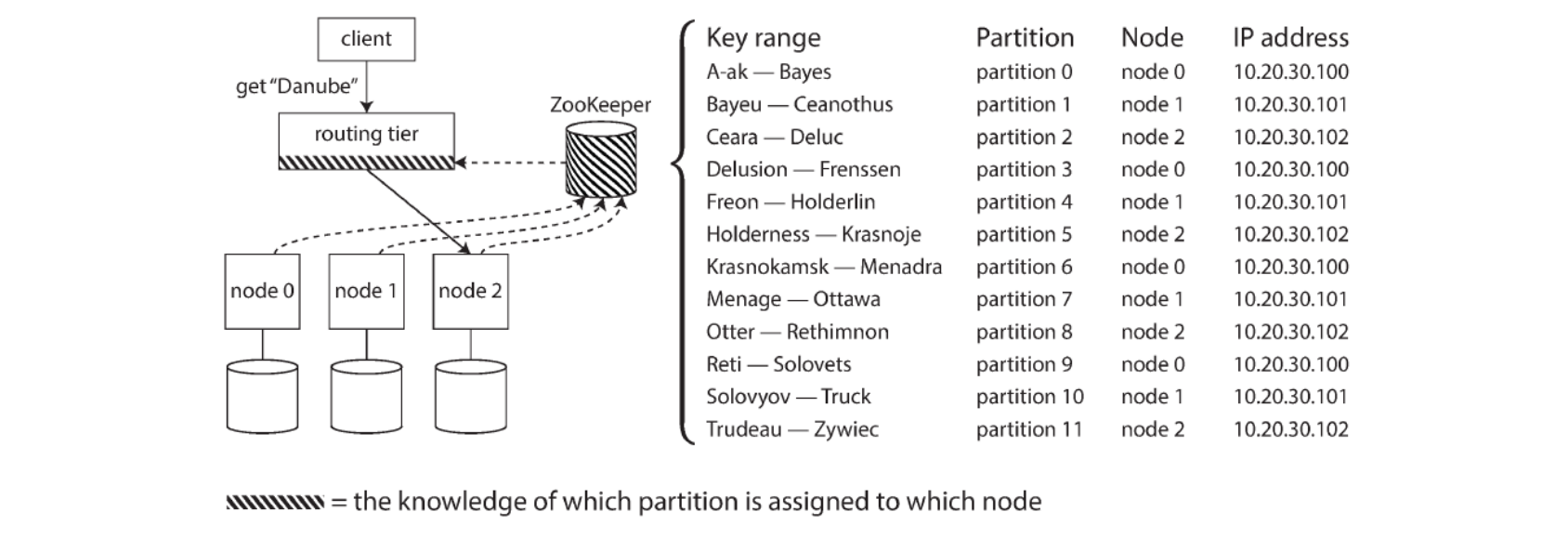
Transactions
failure mid operation
transactions algemeen
figuur (race condition)
Failure mid-operation
DB software or hardware may fail at any time (even in the middle of a write operation)
Application may crash at any time (halfway through a series of operations)
Interruptions in the network can unexpectedly cut off the application from the DB, or the DB node from another
Several clients may write to the DB at the same time, overwriting each other’s changes
A client may read data that does not make sense because it has only partially been updated
Race conditions between clients can cause bugs

Transactions to the rescue
Transactions mechanism of choice for simplifying these issues
Groups several reads and writes into a logical unit
Conceptually all reads and writes in a transaction are executed as one operation: either it succeeds (commit) or it fails (abort, rollback)
If it fails, application can retry
Benefit: no need to worry about partial failure
Drawback: performance impact
Safety guarantees usually described by ACID acronym
Atomicity: if a transaction was aborted, the application can be sure that it did not change anything, so it can be retried
Consistency: application-specific notion of the DB being in a good state e.g. in accounting DB credits and debits must be balanced
While AID are DB properties, the C is a pure application property (and some state it does not belong here)
Isolation: concurrently executing transactions are isolated from each other
Rarely used or even implemented in DBs due to performance implications
Durability: once a transaction has committed successfully, any data it has written will not be forgotten
Transactions: concurrency issue
serializable isolation
If transactions do not touch the same data, they can safely be run in parallel because neither depends on the other
Concurrency issues
One transaction reads data that is concurrently modified by another transaction
Two transactions try to simultaneously modify the same data
Typically triggered when unlucky with timing
Serializable isolation
DB guarantees that transactions have the same effect as if they ran serially (i.e. one at a time)
Incurs heavy performance cost
Common for systems to offer weaker levels of isolation
Transactions: transaction isolation: read commited
algemeen
no dirty read (figuur)
no dirty writes (figuur)
implementing read committed (locks)
Most basic level of transaction isolation
When reading from DB only see data that has been committed (i.e. no dirty reads)
When writing to DB only overwrite data that has been committed (i.e. no dirty writes)
No dirty reads
Any writes by a transaction only become visible to others when that transaction commits

NO DIRTY WRITES
What happens if two transactions concurrently try to update the same object in a DB
Unsure in which order writes will happen but assume later write overwrites earlier
What happens if earlier write is part of a transaction and not committed yet, so later write overwrites an uncommitted value?
Known as dirty write
Usually solved by delaying second write until first write’s transaction has committed or aborted

IMPLEMENTING READ COMMITTED
Prevent dirty writes using row-level locks
Transaction that wants to modify a particular object (row or document) must first acquire a lock on that object
Holds that lock until transaction is committed or aborted
Prevent dirty reads
Use same lock
Ensures a read couldn’t happen while an object has a dirty, uncommitted value (because lock would be held by transaction modifying it)
Does not work well in practice
One long-running write transaction holds up all read-only transactions
Typically: for every object written, DB remembers both old value and new value, and always returns old value until modifying transaction commits